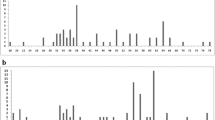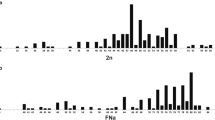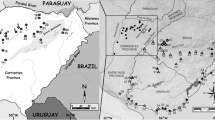Summary
The karyotypes of more than 60 species of Primates are studied and compared, with the use of almost all existing banding techniques. There is a very close analogy of chromosome banding between the Simians studied and man. The quantitative or qualitative variations detected all involve the heterochromatin. It is very likely that all the euchromatin (nonvariable R and Q bands) is identical in all the species.
Approximately 70% of the bands are common to the Simians and to the Lemurs (Prosimians). In the remaining 30%, technical difficulties prevented a valuable comparison, but this does not exclude the possibility that a complete analogy may exist.
Thus, it is very likely that chromosomal evolutions of the Simians, and probably of all the Primates, has occurred without duplication or deficiency of the euchromatin.
Approximately 150 rearrangements could be identified and related to the human chromosomes. The types of rearrangements vary from one group (suborder, family, genus) to another. For instance, Robertsonian translocations are preponderant among the Lemuridae (44/57) but are nonexistent among the Pongidae. Chromosome fissions are very frequent among the Cercopithecidae (10/23), but were not found elsewhere, and pericentric inversions are preponderant in the evolution of Pongidae and man (17/28).
This suggests that the chromosomal evolution may be directed by the genic constitution (favouring the occurrence of a particular type of rearrangement, by enzymatic reaction), by the chromosomal morphology (the probability that Robertsonian translocations will be formed depends at least partially on the number of acrocentrics), and by the reproductive behaviour of the animals.
Reconstitution of the sequence of the chromosomal rearrangements allowed us to propose a fairly precise genealogy of many Primates, giving the positions of the Catarrhines, the Platyrrhines, and the Prosimians. It was also possible to reconstruct the karyotypes of ancestors that died out several dozen million years ago.
The possible role of chromosomal rearrangements in evolution is discussed. It appears necessary to consider different categories of rearrangements separately, depending on their behaviour. The ‘nonfavoured’ rearrangements, such as pericentric inversions, need to occur in an isolated small population for implanting, by an equivalent of genic derivation.
The ‘favoured’ rearrangements, e.g., Robertsonian translocations, may occur and diffuse in panmictic populations, and accumulate. Their role of gametic barrier could be much more progressive.
For discrimination between these two categories, it was necessary to differentiate the selective advantage or disadvantage of the rearrangement itself. It was not possible to show that chromosomal rearrangements play a direct role in modification of the phenotype by position effect.
Comparison of the rearrangements that have occurred during evolution and those detected in the human population shows a strong correlation for some of them. In particular, a large proportion of pericentric inversions can be regarded as reverse mutations, because they reproduce ancestral chromosomes.
Similar content being viewed by others
References
Aurias, A., Prieur, M., Dutrillaux, B., Lejeune, J.: Systematical analysis of 95 translocations of autosomes. Hum. Genet. (in press, 1978)
Bernirschke, K., Bogart, M. H.: Chromosomes of the tan-handed titi (Callicebus torquatus, Hoffmannsegg, 1807). Folia Primatol. (Basel) 25, 25- (1978)
Bloom, S. E., Goodpasture, C.: An improved technique for selective silver staining of nucleolar organizer regions in human chromosomes. Hum. Genet. 34, 199–206 (1976)
Bobrow, M., Madan, K.: A comparison of chimpanzee and human chromosomes, using the Giemsa-11 and other chromosomes banding techniques. Cytogenet. Cell Genet. 12, 107–116 (1973)
Capanna, E., Groop, A., Winkring, H., Noack, G., Civitelli, M. V.: Robertsonian metacentrics in the mouse. Chromosoma 58, 341–353 (1976)
Caspersson, R., Zech, L., Johansson, C., Modest, E. J.: Identification of human chromosomes by DNA-binding fluorescent agents. Chromosoma 30, 215–227 (1970)
Chiarelli, B.: Karyological evolution in Primates and origin of the human karyotype. Atti Ass. Gen. Ital. 7, 284–285 (1962)
Chu, E. H. Y., Bender, M. A.: Cytogenetics and evolution of primates. Ann. NY Acad. Sci. 102, 253–266 (1962)
Dallapiccola, B., Mastroiacovo, P., Gandini, E.: Centric fission of chromosome no. 4 in the mother of two patients with trisomy 4p. Hum. Genet. 31, 121–125 (1976)
Dutrillaux, B.: Les aberrations chromosomiques transmissibles. In: Journées Parisiennes de Pédiatrie, pp. 13–21. Paris: Flammarion, 1972
Dutrillaux, B.: Nouveau système de marquage chromosomique: les bandes T. Chromosoma 41, 395–402 (1973)
Dutrillaux, B.: Obtention de plusieurs marquages chromosomiques sur les mêmes préparations, après traitement par le BrdU. Humangenetik 30, 297–306 (1975a)
Dutrillaux, B.: Sur la nature et l'origine des chromosomes humains. Paris: Expansion 1975b
Dutrillaux, B.: Study of human X chromosomes with the 5-BrdU-acridine orange technique. Application to X chromosome pathology. Chromosomes today, Vol. 5, pp 395–407. Amsterdam: Elsevier/North-Holland Biomedical Press 1976
Dutrillaux, B.: Advances in Cytogenetics. In: J. W. Lillefield, J. de Grouchy (eds.), pp. 427–429. Amsterdam-Oxford: Excerpta Medica, 1977
Dutrillaux, B., Lejeune, J.: Sur une nouvelle technique d'analyse du caryotype humain. C. R. Acad. Sci. [D] (Paris) 272, 2638–2640 (1971)
Dutrillaux, B., Rumpler, Y.: Chromosomal evolution in Malagasy lemurs. II. Meiosis in intra-and interspecific hybrids in the genus Lemur. Cytogenet. Cell Genet. 18, 197–211 (1977)
Dutrillaux, B., Grouchy, J. de, Finaz, C., Lejeune, J.: Mise en évidence de la structure fine des chromosomes humains par digestion enzymatique (pronase en particulier). C.R. Acad. Sci. [D] (Paris) 273, 587–588 (1971)
Dutrillaux, B., Laurent, C., Couturier, J., Lejeune, J.: Coloration par l'acridine orange de chromosomes préalablement traités par le 5-bromodéoxyuridine (BudR). C.R. Acad. Sci. [D] (Paris) 276, 3179–3181 (1973a)
Dutrillaux, B., Réthoré, M. O., Prieur, M., Lejeune, J.: Analyse de la structure fine des chromosomes du Gorille (Gorilla-gorilla). Comparaison avec Homo sapiens et Pan troglodytes. Humangenetik 20, 347–354 (1973b)
Dutrillaux, B., Laurent, C., Gilgenkrantz, S., Frederic, J., Carpentier, S., Couturier, J., Lejeune, J.: Les translocations du chromosome X. Analyse après traitement par le BudR et coloration par l'acridine orange. Helv. paediat. Acta [Suppl.] 34, 19–31 (1974)
Dutrillaux, B., Réthoré, M. O., Lejeune, J.: Analyse du caryotype de Pan paniscus. Comparaison avec les autres Pongidae et l'Homme. Humangenetik 28, 113–119 (1975a)
Dutrillaux, B., Réthoré, M. O., Lejeune, J.: Comparaison du caryotype de l'orang outang à celui de l'homme, du chimpanzé et du gorille. Ann. Genet. (Paris) 18, 153–161 (1975b)
Dutrillaux, B., Réthoré, M. O., Aurias, A., Goustard, M.: Analyse du caryotype de deux espèces de gibbons (Hylobates lar et Hylobates concolor). Cytogenet. Cell Genet. 15, 81–91 (1975c)
Dutrillaux, B., Couturier, J., Richer, C. L., Viegas-Péquignot, E. Sequence of DNA replication in 277 R- and Q-bands of human chromosomes using a BrdU treatment. Chromosoma 58, 51–61 (1976)
Dutrillaux, B., Aurias, A., Couturier, J., Croquette, E., Viegas-Péquignot, E.: Multiple telomeric fusions and chain configurations in human somatic chromosomes. In: Chromosomes today, Vol. 6, Chapelle, A. de la, Sorsa, M. (eds.), pp. 37–44. Amsterdam: Elsevier/North-Holland Biomedical Press 1977
Dutrillaux, B., Viegas-Péquignot, E., Dubos, C., Masse, R.: Complete or almost complete analogy of chromosome banding between the baboon (Papio papio) and man. Hum. Genet. 43, 37–46 (1978a)
Dutrillaux, B., Viegas-Péquignot, E., Couturier, J., Chauvier, G.: Identity of euchromatic bands from man to Cercopithecidae (Cercopithecus aethiops, Cercopithecus sabaeus, Erythrocebus patas, Miopithecus talapoin). Hum. Genet. (in press, 1978b)
Dutrillaux, B., Couturier, J., Viegas-Péquignot, E., Chauvier, G., Trebbau, P.: Présence d'une hétérochromatine abondante dans le caryotype de deux Cebus: C. capucinus and C. nigricittatus. Ann. Genet. (Paris) 21, 142–148 (1978c)
Dutrillaux, B., Croquette, M. F., Viegas-Péquignot, E., Aurias, A., Coget, J., Couturier, J., Lejeune, J.: Human chromosomes chains and rings. A preliminary note on end-to-end fusions. Cytogenet. Cell Genet. 20, 70–77 (1978d)
Dutrillaux, B., Biémont, M. C., Viegas-Péquignot, E., Laurent, C.: Comparison of the karyotypes of four Cercopithecidae: Papio papio, P. anubis, Macaca mulatta and M. fascicularis. Cytogenet. Cell Genet. 23, 77–83 (1979)
Egozcue, J., Caballin, M. R., Goday, C.: Banding patterns of the chromosomes of man and the chimpanzee. Humangenetik 18, 77–80 (1973a)
Egozcue, J., Aragonés, J., Caballin, M. R., Goday, C.: Banding patterns of the chromosomes of man and gorilla. Ann. Genet. (Paris), 16, 207–210, (1973b)
Ferguson-Smith M. A.: Inherited constriction fragility of chromosome 2. Ann. Genet. (Paris) 16, 35–38 (1973)
Finaz, C.: Comparaison des cartes géniques des primates: homme, chimpanzé, orang-outan, babouin et cercopithèque. Thesis doct. ès Sci., Paris, 1978
Finaz, C., Nguyen van Cong, Cochet, C., Frezal, J., Grouchy, J. de: Fifty-million-year evolution of chromosome 1 in the primates: evidence from banding and gene mapping. Cytogenet. Cell Genet. 18, 160–164 (1977)
Ford, C. E., Madan, K.: Branched chromosomes: an alternative to the hypothesis of selective endoreduplication. In: Chromosome identification—Technique and applications in biology and medicine, Caspersson, T., Zech, L. (eds.). Stockholm, New York, London: Nobel Foundation and Academic Press 1973
Fredga, K., Nawrin, J.: Karyotype variability in Sorex araneus. 1. Insectivora, Mammalia. In: Chromosomes today, Vol. 6. Chapelle, A. de la, Sorsa, M. (eds.), pp 153–161. Amsterdam: Elsevier/North-Holland Biomedical Press 1977
Gagné, R., Laberge, C.: Specific cytological recognition of the heterochromatic segment of number 9 chromosome in Man. Exp. Cell Res. 73, 239–241 (1972)
Garver, J. J., Estop, A., Pearson, P. L., Dijkman, T. M., Wijnen, L. M. M., Meera Khan, P. Comparative gene mapping in the Pongidea and Cercopithecoidea. In: Chromosomes today, Vol. 6 Chapelle, A. de la, Sorsa, M. (eds.), pp. 191–199. Amsterdam: Elsevier/North-Holland Biomedical Press 1977
Gosden, J. R., Mitchell, A. R., Seuanez, H. N., Gosden, C. M.: The distribution complementary to human satellite I, II, and IV in the chromosomes of chimpanzee (Pan troglodytes), gorilla (Gorilla gorilla), and orangutan (Pongo pygmaeus). Chromosoma 63, 253–271 (1977)
Grouchy, J. de: Cancer and the evolution of species: a ransom. Biomedicine 18, 6–8 (1973)
Grouchy, J. de: De la naissance des espèces aux aberrations de la vie. R. Laffont 1978
Grouchy, J. de, Turleau, C., Roubin, M., Klein, M.: Evolution caryotypique de l'homme et du chimpanzé: étude comparative des topographies de bandes après dénaturation ménagée. Ann. Genet. (Paris) 15, 79–84 (1972)
Grouchy, J. de, Finaz, C., Nguyen van Cong: Comparative banding and gene mapping in primates evolution. Evolution of chromosome 1 during fifty million years. In: Chromosomes today, Vol. 6. Chapelle, A. de la, Sorsa, M. (eds.), pp 183–190. Amsterdam: Elsevier/North-Holland Biomedical Press 1977
Hamerton, J. L.: Robertsonian translocations in man: evidence for prezygotic selection. Cytogenetics 7, 260–276 (1968)
Hamerton, J. L., Klinger, H. P., Mutton, D. E., Lang, E. M.: The somatic chromosomes of the Hominoidea. Cytogenetics 2, 240–263 (1963)
Hamerton, J. L., Canning, N., Ray, M., Smith, S.: A cytogenetic survey of 14,069 newborn infants. I. Incidence of chromosome abnormalities. Clin. Genet. 8, 223–243 (1975)
Hansen, S.: A case of centric fission in man. Humangenetik 26, 257–259 (1975)
Henderson, A. S., Warburton, D., Atwood, K. C.: Location of ribosomal DNA in the human chromosome complement. Proc. Natl. Acad. Sci. USA 69, 3394–3398 (1972)
Henderson, A. S., Warburton, D., Atwood, K. C.: Localisation of rDNA in the chromosome complement of the Rhesus (Macaca mulutta). Chromosoma 44, 367–370 (1974)
Henderson, A. S., Warburton, D., Megraw-Ripley, S., Atwood, K. C.: The chromosomal location of rDNA in selected lower primates. Cytogenet. Cell Genet. 19, 281–302 (1977)
Hsu, T. C., Bernirschke, K.: Mammalian chromosome atlas. New York: Springer 1967–1977
Jones, K. W: Annotation: satellite DNA. J. Med. Genet. 10, 273–276 (1973)
Jones, K. W.: Repetitive DNA sequences in animals, particularly primates. In: Chromosomes today, Vol. 5. Pearson, P. L., Lewis, K. R. (eds.), pp. 305–313, New York: Halsted 1974
Jones, K. W.: Repetitive DNA and primate evolution: In: Molecular structure of human chromosomes. Yunis, J. J. (ed.), pp. 295–326. New York, San Francisco, London: Academic Press 1977
Jones, K. W., Corneo, G.: Location of satellite and homogeneous DNA sequences on human chromosomes. Nature 233, 238–239 (1971)
Jones, K. W., Prosser, J., Corneo, G., Ginelli, E., Bobrow, M.: Satellite DNA constitutive heterochromatin and human evolution. In: Modern aspects of cytogenetics: constitutive heterochromatin in man, Pfeiffer, F. K. (ed.), pp. 45–61. (Symp. Med. Hoechst, no. 6). Stuttgart: Schattauer 1972
Klinger, H. P.: The somatic chromosomes of some primates (Tupaia glis, Nycticebus coucang, Tarsius bancanus, Cercocebus aterrimus, Symphalangus syndactylus). Cytogenetics 2, 140–151 (1963)
Lejeune, J.: Sur les mécanismes de la spéciation. C.R. Soc. Biol. (Paris) 169, 828–845 (1975)
Lejeune, J., Dutrillaux, B., Lafourcade, J., Berger, R., Abonyi, D., Réthoré, M. O.: Endoreduplication sélective du bras long du chromosome 2 chez une femme et sa fille. C.R. Acad. Sci. [D] (Paris) 266, 24–26 (1968)
Lejeune, J., Dutrillaux, B., Grouchy, J. de: Reciprocal translocations in human population. A preliminary analysis. In: Population cytogenetics. Edinburgh: University Press 1970
Lejeune, J., Dutrillaux, B., Réthoré, M. O., Prieur, M.: Comparaison de la structure fine des chromatides d'Homo sapiens et de Pan troglodytes. Chromosoma 43, 423–444 (1973)
Lin, C. C., Chiarelli, B., Boer, L. E. M. de, Cohen, M. M.: A comparison of the fluorescent karyotype of the chimpanzee (Pan troglodytes) and man. J. Hum. Evol. 2, 311–321 (1973)
Miller, D. A., Firschein, I. L., Dev, V. G., Tantravahi, R., Miller, O. J.: The Gorilla karyotype: chromosome lengths and polymorphisms. Cytogenet. Cell Genet. 13, 536–550 (1974)
Miller, C. K., Miller, D. A., Miller, O. J., Tantravahi, R., Reese, R. T.: Banded chromosomes of the owl monkey, Aotus trivirgatus. Cytogenet. Cell Genet. 19, 215–226 (1977)
Mitchell, A. R., Seuanez, H. N., Lawrie, S. S., Martin, D. E., Gosden, J. R.: The location of DNA homologous to human satellite III DNA in the chromosomes ofchimpanzee (Pan troglodytes), gorilla (Gorilla gorilla) and orangutan (Pongo pygmaeus). Chromosoma 61, 345–358 (1977)
Nielsen, J., Sillesen, I.: Incidence of chromosome aberration among 11,148 newborn children. Humangenetik 30, 1–12 (1975)
Noel, B., Quack, B., Mottet, J., Nantois, Y., Dutrillaux, B.: Selective endoreduplication or branched chromosomes. Exptl. Cell Res. 104, 423–426 (1977)
Ohno, S.: Sex chromosomes and sex-linked genes. Monogr. Endocrinol. 1 (whole issue) (1967)
Paris Conference (1971), Birth Defects: Original Article Series. The National Foundation, Vol. 8, n°7. New York 1972
Paris Conference (1971), Supplement (1975), Birth Defects: Original Article Series. The National Foundation, Vol. II, n°9. New York 1975
Pearson, P.: The uniqueness of the human karyotype. In: Chromosome identification — Techniques and applications in biology and medicine, Caspersson, T., Zech, L. (eds.), pp. 141–145. Stockholm, New York, London: Nobel Foundation and Academic Press 1973
Pearson, P., Estop, A., Garver, J. J., Dijksman, T. T., Wijnen, L. M. M., Meera Khan, P.: Evidence for the origin of human chromosome 2, 9 and 14 from primate-rodent cell hybrids. In: Chromosomes today, Vol. 6. Chapelle, A. de la, Sorsa, M. (eds.), pp. 201–207. Amsterdam: Elsevier/North-Holland Biomedical Press 1977
Rumpler, Y., Dutrillaux, B.: Chromosome evolution in Malagasy lemurs. I. Chromosome banding studies in the genuses Lemur and Microcebus. Cytogenet. Cell Genet. 17, 268–281 (1976)
Rumpler, Y., Dutrillaux, B.: Chromosomal evolution in Malagasy lemurs. III. Chromosome banding studies in the genus Lemur and the species Lemur catta. Cytogenet. Cell Genet. 21, 201–211 (1978)
Singh, L.: Evolution of karyotypes in snakes. Chromosoma 38, 185–236 (1972)
Sinha, A. K., Pathak, S., Nora, J. J.: A human family suggesting evidence for centric fission and stability of a telocentric chromosome. Hum. Hered. 22, 423–429 (1973)
Stock, A. D., Hsu, T. C.: Evolutionary conservatism in arrangement of genetic material. A comparative analysis of chromosome banding between the Rhesus macaque (2n=42, 84 arms) and the African green monkey (2n=60, 120 arms). Chromosoma 43, 211–224 (1973)
Sumner, A. T.: A simple technique for demonstrating centromeric heterochromatin. Exp. Cell Res. 75, 304–306 (1972)
Sumner, A. T., Evans, H. J., Buckland, R. A.: A new technique for distinguishing between human chromosomes. Nature New Biol. 232, 31–33 (1971)
Takaji, N., Sasaki, M.: A phylogenetic study of bird karyotype. Chromosoma 46, 91–120 (1974)
Tantravahi, R., Miller, D. A., Dev, V. G., Miller, O. J.: Detection of nucleolus organizer in chromosomes of human, chimpanzee, gorilla, orangutan, and gibbon. Chromosoma 56, 15–27 (1976)
Thelen, T. H., Abrams, D. J., Fisch, R. D.: Multiple abnormalities due to possible genetic inactivation in an X-autosome translocation. Am. J. Hum. Genet. 23, 410–418 (1971)
Turleau, C., Grouchy, J. de: Caryotypes de l'homme et du chimpanzé. Comparaison de la topographie des bandes. Mécanismes évolutifs possibles. C.R. Acad. Sci. [D] (Paris) 274, 2355–2357 (1972)
Turleau, C., Grouchy, J. de: New observations on the human and chimpanzee karyotypes. Identification of breakage points of pericentric inversions. Humangenetik 20, 151–157 (1973)
Turleau, C., Grouchy, J. de, Klein, M.: Phylogénie chromosomique de l'homme et des primates hominiens (Pan troglodytes, Gorilla gorilla, et Pongo pygmaeus). Essai de reconstitution du caryotype de l'ancêtre commun. Ann. Genet. (Paris) 15, 225–240 (1972)
Viegas-Péquignot, E., Couturier, J., Dutrillaux, B.: Comparison of DNA-replication chronology in chromosomes of chimpanzee and man. Primates 19, 209–213 (1978)
Warburton, D., Firschein, I. L., Miller, D. A., Warburton, F. E.: Karyotype of the chimpanzee, Pan troglodytes, based on measurements and banding pattern: comparison to the human karyotype. Cytogenet. Cell Genet. 12, 453–461 (1973)
Author information
Authors and Affiliations
Rights and permissions
About this article
Cite this article
Dutrillaux, B. Chromosomal evolution in Primates: Tentative phylogeny from Microcebus murinus (Prosimian) to man. Hum Genet 48, 251–314 (1979). https://doi.org/10.1007/BF00272830
Received:
Issue Date:
DOI: https://doi.org/10.1007/BF00272830




